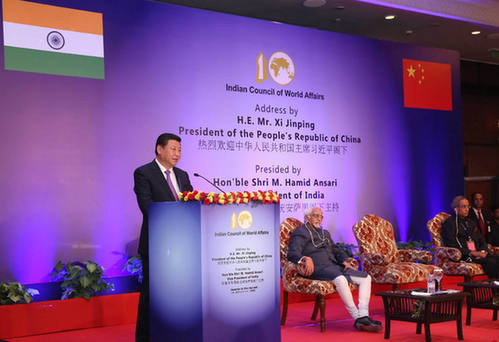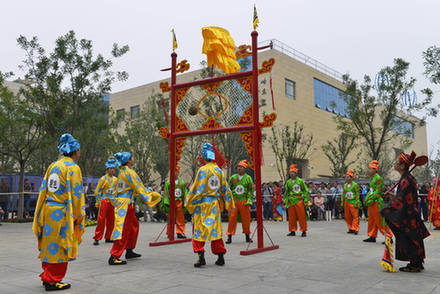China’s New Diplomatic Blueprint for South Asia
President Xi Jinping delivers a speech titled In Joint Pursuit of a Dream of National Renewal at the Indian Council of World Affairs on September 18, 2014. Photos by Xinhua

Cooperation Framework
During Xi’s visits, China developed top-level design and strategic planning in bilateral ties together with the Maldives and Sri Lanka respectively, and provided strategic guidance for development of bilateral relations together with India. According to President Yameen, though the Maldives is a small island nation, China respects and attaches importance to the country. The Maldives-China relationship is a model for mutual respect and reciprocal cooperation between big and small countries. During Xi’s visit, the two top leaders agreed to establish a future-oriented, all-round, friendly and cooperative partnership between their two countries.
China-Sri Lanka relations, positioned in 2013 as a strategic cooperative partnership of sincerity, mutual help and everlasting friendship, have become indispensable to both countries’ diplomatic policies. In Xi’s visit to Sri Lanka this year, the two sides signed the action plan to deepen the strategic cooperative partnership, indicating the direction and foundation of buttressing the strategic cooperative partnership, and launched a series of projects.
China and India, apart from fostering a strategic partnership for peace and prosperity, have realized that their progress may help each other forward and have vowed to forge a closer development partnership that will be a core component of their strategic and cooperative venture.
China’s willingness to more deeply engage in South Asia’s economic development is supported by the countries in that region, while China equally backs these countries that wish to join the SCO. Reciprocal developments in this regard abound: The Maldives hails China’s contribution to the development of the South Asian Association for Regional Cooperation (SAARC) and pledges to support China’s efforts to upgrade its relationship with SAARC; Sri Lanka expects China to contribute more to SAARC as an observer and encourages China to further its cooperation with the association; India agrees to expand its collaboration with China within Asian regional cooperation organizations; and China welcomes Sri Lanka to join the Asian Infrastructure Investment Bank as a founding member, attaches importance to and supports Sri Lanka’s application for SCO observer status, and is willing to promote all-round cooperation between the SCO and Sri Lanka.
China and India reached a consensus that the priority in Asia is maintaining regional peace and stability while advancing common development of the region. Both countries concur that an open, transparent, equal and inclusive security and cooperation framework based on the fundamental principles of international law should be set up, and they support regional multilateral cooperation mechanisms in Asia.
With regards to global issues, China will enhance coordination with the Maldives in various fields including climate change. In addition, it vows to boost communication and cooperation with Sri Lanka within multilateral mechanisms including the UN and increase cooperation in such fields as human rights, climate change, counterterrorism and combating transnational crime to jointly safeguard the common interests of developing nations. China-India cooperation is even more significant both regionally and globally. India is the biggest country in South Asia and China is its biggest neighbor. Only by joining forces can the two powers stimulate regional peace, stability and prosperity. As two major developing countries, China and India are faced with similar challenges; they have extensive common interests and shoulder great responsibilities in safeguarding the common interests of developing nations and making the international political and economic orders more just and equitable, which requires strong strategic cooperation in global affairs. “If we (China and India) speak with one voice, the whole world will listen, and if we join hands, the whole world will pay attention,” President Xi said during his visit to India.
Over the past year, Xi Jinping has traveled to 13 countries in Central Asia, Southeast Asia, Northeast Asia and South Asia, fostering a favorable neighboring environment for China. Aiming to promote peace, stability and prosperity, his trip to South Asia improved bilateral relations between China and its neighboring countries and advanced the “One Belt, One Road” concept while establishing a future cooperation framework with South Asian countries. However, religious and ethnic conflicts in the region, India’s hegenomic aspirations in South Asia, and the current turbulence in Central Asia have fueled uncertainty about regional development. China has a long way to go in fulfilling its South Asia strategy.
LIN MINWANG is an associate professor at the Institute of International Relations of China Foreign Affairs University and the Collaborative Innovation Center for South China Sea Studies.

